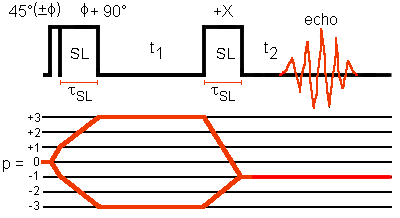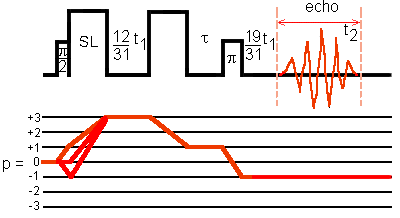Rotation Induced Adiabatic Coherence Transfer MQ-MAS
Wu and coworkers introduced RIACT method for converting MQ into 1Q coherences by exploiting the periodic variation of the energy level system for a half-integer quadrupole nucleus under MAS.
This periodic energy variation is caused by the modulation of the quadrupole coupling, due to the spinning of the sample at the frequency of the rotor.
The presence of an RF magnetic field may induce coherence transfers, provided the evolution of the energy level is adiabatic.

The RIACT(II) sequence of Wu and coworkers consists of two spin-locking passages: the first to create the 3Q coherence, and the second to convert it to the 1Q coherence.
The spin-locking duration tauSL is set to 1/4 of the rotation period of the rotor.
Lim and Grey proved that this method does not excite the whole powder uniformly. As a result, the anisotropic lineshape differs from those obtained by MAS.
The central-transition coherence is created directly by the application of a 45° pulse, which corresponds to an effective 90° pulse for the central transition of S = 3/2 nuclei.
In principle, the central-transition coherence is then converted to the triple-quantum coherences by the zero-crossings in the quadrupole coupling that occur during the first spin-locking pulse.
After evolution for the time interval t1, the triple-quantum coherences are then converted back to the central-transition coherence by the second spin-locking pulse and the signal is detected.
Since RIACT directly produced the 3Q -> -1Q coherence transfer, coherence transfer pathways in any amplitude-modulated experiment sequence would not be symmetric. As a result, amplitude-modulated experiment should not generate pure absorption 2D lineshape.
For a spin I = 3/2 and 3QMAS experiment,
0Q -> +3Q -> -1Q is the anti-echo pathway,
0Q -> -3Q -> -1Q is the echo pathway.
For the other half-integer spins and 3QMAS experiment,
0Q -> +3Q -> -1Q is the echo pathway,
0Q -> -3Q -> -1Q is the anti-echo pathway.
ACQUISITION: Hyper-complex or TPPI
Shearing transformation is required to obtain 2D isotropic (in F1 dimension) anisotropic (in the F2 dimension) correlation spectrum.
Mildner and coworkers introduced split-t1 approach in RIACT(II) sequence.

On the other hand, phase-modulated experiment such as split-t1 provides 2D pure absorption spectra. The above numerical values are for 3QMAS applied to a spin I = 5/2 system.
Tau is set to a multiple of the rotation period of the rotor.
The MQ coherences are mostly created from the MQ z-magnetization components in the single-pulse method, while the central-transition coherences are used to produce MQ coherences in the RIACT method. It is possible to increase the sensitivity of the MQ excitation by exploiting both mechanisms.
If a soft solid pi/2 pulse, which creates only central-transition coherences, is followed by a subsequent high power spin-locking pulse, then MQ coherences can be created from both the central-transition coherences via the adiabatic coherence transfer and from the MQ z-magnetization.
ACQUISITION: F1-QF
Shearing transformation is avoided.
